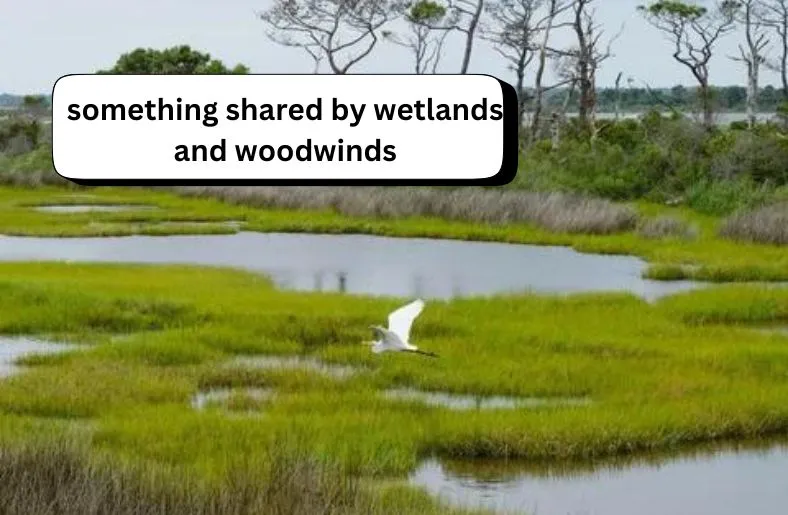1. Introduction: Unveiling the Connection
Something shared by wetlands and woodwinds may seem odd at first. Wetlands are natural water areas like swamps and marshes, while woodwinds are musical instruments. These two might appear very different, but they share some surprising connections.
When you look deeper, you see that both something shared by wetlands and woodwinds rely on natural harmony. Wetlands are full of life and sounds, just like how woodwinds create music through vibrations. This blog will explore how these two worlds intersect.
We will cover the unique aspects of something shared by wetlands and woodwinds, their similarities, and their roles in nature and music. By the end of this post, you’ll understand how something shared by wetlands and woodwinds connects in ways you might not have expected.
2. The Essence of Wetlands
Wetlands are areas where water and land meet, creating unique environments. They include swamps, marshes, bogs, and fens. These places are vital for nature because they filter water, control flooding, and provide habitats for many species.
The sounds of wetlands are distinct. You hear the rustling of reeds, the croaking of frogs, and the calls of birds. These sounds create a natural symphony that adds to the wetland’s rich biodiversity.
Wetlands support a wide range of plants and animals. They play a key role in maintaining ecological balance and ensuring the health of the environment. Their vibrant life and sounds make them essential to our planet, reflecting a part of something shared by wetlands and woodwinds.
3. The Magic of Woodwinds
Woodwinds are a type of musical instrument made from wood or metal. They include the flute, clarinet, oboe, and bassoon. These instruments produce sound by making air vibrate inside them.
For example, flutes create sound when air is blown across an opening, while clarinets and oboes use reeds to produce their unique tones. Each woodwind has a different sound that contributes to various types of music.
Woodwinds play a significant role in creating expressive and emotional music. Their diverse sounds add depth to musical performances and bring music to life, much like how something shared by wetlands and woodwinds blends natural and musical harmony.
4. Shared Characteristics: Ecological and Acoustic Harmony
Something shared by wetlands and woodwinds involves resonance and vibration. Wetlands create natural resonance with their flowing water and plant life. Woodwinds produce sound through air columns and reeds.
Both wetlands and woodwinds are adaptable. Wetlands support diverse species and adjust to environmental changes. Woodwinds can produce a range of sounds and fit various musical styles.
The natural beauty of wetlands and the sound of woodwinds create a rich sensory experience. Their harmony and versatility reflect how something shared by wetlands and woodwinds shows a deeper connection than first meets the eye.
5. Cultural Connections: Nature and Music
Music has long been inspired by nature. The sounds of wetlands, like croaking frogs and rustling reeds, have influenced many musical compositions. These natural sounds are reflected in the music created with woodwinds.
Early woodwind instruments were made from natural materials, such as reeds found in wetlands. This highlights the deep connection between nature and music, showing how something shared by wetlands and woodwinds influences each other.
Woodwinds often mimic natural sounds, blending music with the environment. This cultural connection underscores how our understanding of nature, reflected in something shared by wetlands and woodwinds, can shape and inspire musical creativity.
6. The Ecological Importance of Sound
Sound plays a crucial role in wetlands for communication and survival. Animals like amphibians and birds use sound to interact with each other, helping to maintain the health of the wetland environment.
Woodwinds also contribute to our acoustic landscapes. They evoke emotions and memories, connecting people to their surroundings. The sounds from both natural wetlands and woodwind instruments shape our cultural and environmental experiences, emphasizing something shared by wetlands and woodwinds.
Understanding the role of sound in both environments helps us appreciate their importance. It shows how something shared by wetlands and woodwinds impacts our perceptions and highlights the beauty of both worlds.
7. Preservation and Conservation Efforts
Wetlands face many threats, including pollution and climate change. Conserving these areas is vital for preserving biodiversity and preventing natural disasters like floods. Protecting wetlands ensures their health and the survival of their inhabitants.
Woodwind music also faces challenges, such as changes in technology and education. Keeping traditional woodwind music alive requires effort and support from communities and institutions.
Music and art can play a role in environmental conservation by raising awareness. They help highlight the importance of preserving both wetlands and woodwind traditions, encouraging action for a sustainable future. Something shared by wetlands and woodwinds can inspire efforts to protect both nature and music.
Conclusion
In exploring something shared by wetlands and woodwinds, we uncover a fascinating connection between nature and music. Wetlands, with their unique sounds and vital ecological roles, and woodwind instruments, with their expressive tones, both rely on resonance and harmony. Their shared characteristics highlight a deeper interplay between natural environments and musical creations. Understanding this connection enriches our appreciation for both the beauty of wetlands and the art of woodwind music. By recognizing and preserving these links, we can foster greater respect for our environment and cultural heritage, ensuring that the harmony of something shared by wetlands and woodwinds continues to inspire us.





